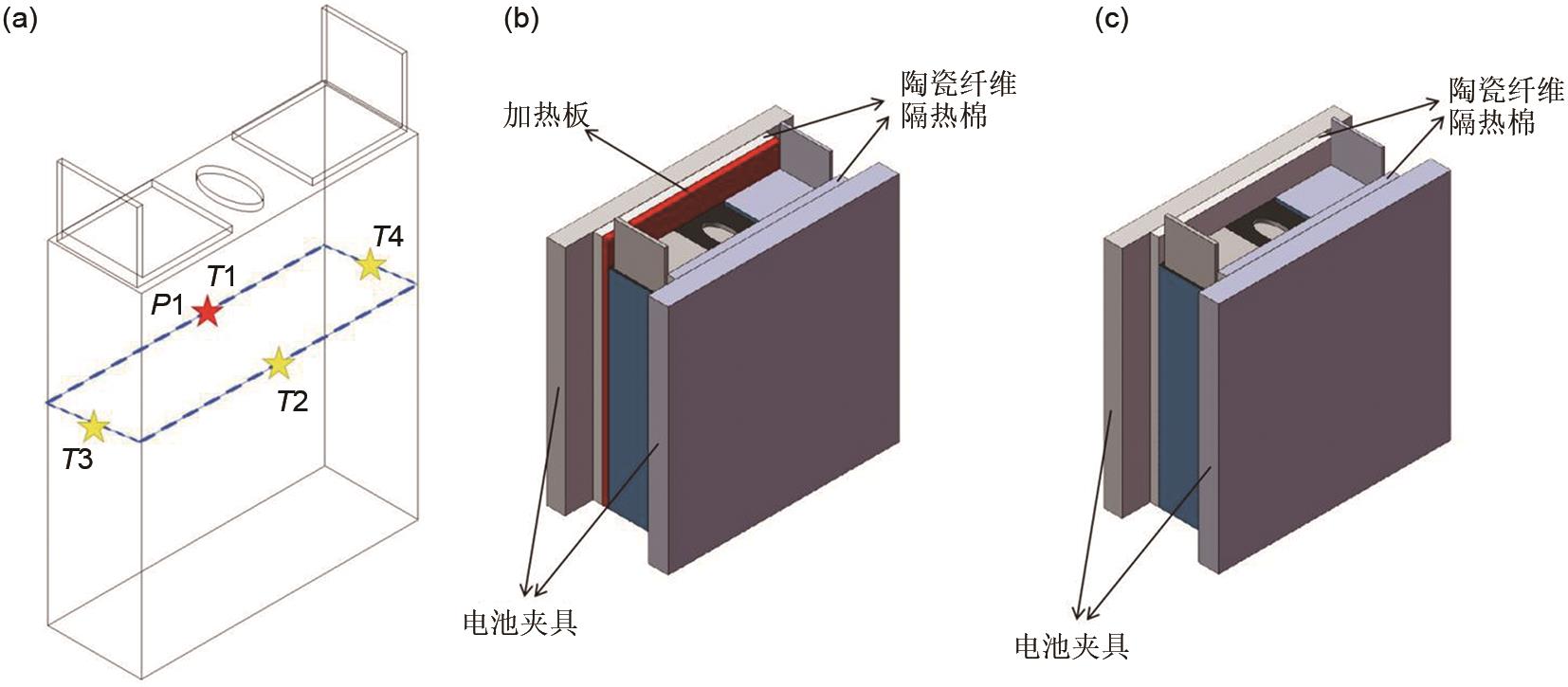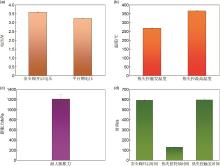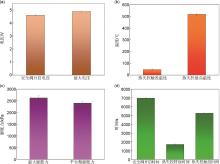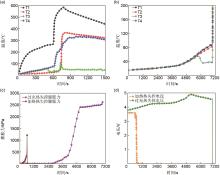Energy Storage Science and Technology ›› 2025, Vol. 14 ›› Issue (10): 3942-3954.doi: 10.19799/j.cnki.2095-4239.2025.0349
• Energy Storage Test: Methods and Evaluation • Previous Articles Next Articles
Jingyun WU1( ), Pengyu GUO2(
), Pengyu GUO2( ), Zheng HUANG1
), Zheng HUANG1
Received:2025-04-09
Revised:2025-04-25
Online:2025-10-28
Published:2025-10-20
Contact:
Pengyu GUO
E-mail:673112739@qq.com;13611511237@163.com
CLC Number:
Jingyun WU, Pengyu GUO, Zheng HUANG. Experimental study on the thermal-runaway characteristics of sodium-ion batteries under different abuse conditions[J]. Energy Storage Science and Technology, 2025, 14(10): 3942-3954.

Fig. 1
(a) Schematic diagram of thermocouple and expansion force sensor arrangement (T: thermocouple measurement points; P: expansion force sensor measurement points); (b) Schematic diagram of battery structure and experimental setup for Test 1; (c) Schematic diagram of battery structure and experimental setup for Test 2"


Fig. 4
Error bar diagrams of key parameters during heating-induced thermal runaway. (a) Error bar diagram of key voltage parameters; (b) Error bar diagram of key temperature parameters; (c) Error bar diagram of key expansion force parameters; (d) Error bar diagram of key time node parameters"


Fig. 6
Error bar diagrams of key parameters during overcharge-induced thermal runaway: (a) Error bar diagram of key voltage parameters; (b) Error bar diagram of key temperature parameters; (c) Error bar diagram of key expansion force parameters; (d) Error bar diagram of key time node parameters"


Fig. 7
Comparative analysis of sodium-ion battery thermal runaway behavior under different abuse conditions: (a) Temperature variation curve during heating-induced thermal runaway; (b) Temperature variation curve during overcharge-induced thermal runaway; (c) Expansion force variation curves under different abuse conditions; (d) Voltage variation curves under different abuse conditions"

| [1] | 李勇琦, 李志远, 闻有为, 等. 大容量钠离子电池热失控特性实验研究[J]. 储能科学与技术, 2025, 14(4): 1657-1667. DOI: 10.19799/j.cnki.2095-4239.2024.1044. |
| LI Y Q, LI Z Y, WEN Y W, et al. Experimental study of thermal runaway characteristics of large-capacity sodium-ion batteries[J]. Energy Storage Science and Technology, 2025, 14(4): 1657-1667. DOI: 10.19799/j.cnki.2095-4239.2024.1044. | |
| [2] | 闻有为, 滕安琪, 李勇琦, 等. 不同放电倍率下钠离子电池的电性能与产热行为[J]. 储能科学与技术, 2025, 14(4): 1687-1697. DOI: 10.19799/j.cnki.2095-4239.2024.1047. |
| WEN Y W, TENG A Q, LI Y Q, et al. Electrical performance and heat production behavior of sodium-ion batteries at different discharge rate[J]. Energy Storage Science and Technology, 2025, 14(4): 1687-1697. DOI: 10.19799/j.cnki.2095-4239. 2024. 1047. | |
| [3] | WANG G Q, PING P, PENG R Q, et al. A semi reduced-order model for multi-scale simulation of fire propagation of lithium-ion batteries in energy storage system[J]. Renewable and Sustainable Energy Reviews, 2023, 186: 113672. DOI: 10.1016/j.rser.2023.113672. |
| [4] | WANG G Q, PING P, KONG D P, et al. Advances and challenges in thermal runaway modeling of lithium-ion batteries[J]. The Innovation, 2024, 5(4): 100624. DOI: 10.1016/j.xinn.2024.100624. |
| [5] | 张明杰, 杨凯, 刘振, 等. 钠离子电池热安全性研究进展[J]. 电池, 2025, 55(2): 368-375. DOI: 10.19535/j.1001-1579.2025.02.028. |
| ZHANG M J, YANG K, LIU Z, et al. Research progress in thermal safety for sodium-ion battery[J]. Battery Bimonthly, 2025, 55(2): 368-375. DOI: 10.19535/j.1001-1579.2025.02.028. | |
| [6] | YUE Y B, JIA Z Z, LI Y Q, et al. Thermal runaway hazards comparison between sodium-ion and lithium-ion batteries using accelerating rate calorimetry[J]. Process Safety and Environmental Protection, 2024, 189: 61-70. DOI: 10.1016/j.psep. 2024.06.032. |
| [7] | FEDORYSHYNA Y, SCHAEFFLER S, SOELLNER J, et al. Quantification of venting behavior of cylindrical lithium-ion and sodium-ion batteries during thermal runaway[J]. Journal of Power Sources, 2024, 615: 235064. DOI: 10.1016/j.jpowsour. 2024. 235064. |
| [8] | GUI Q H, XU B, YU K, et al. Comparison of NaNi1/3Fe1/3Mn1/3O2 and Na4Fe3(PO4)2(P2O7) cathode sodium-ion battery behavior under overcharging induced thermal runaway[J]. Chemical Engineering Journal, 2024, 497: 154732. DOI: 10.1016/j.cej. 2024. 154732. |
| [9] | LI Q J, LI Y, LIU M Q, et al. Elucidating thermal decomposition kinetic mechanism of charged layered oxide cathode for sodium-ion batteries[J]. Advanced Materials, 2025, 37(10): 2415610. DOI: 10.1002/adma.202415610. |
| [10] | RUI B, SUN S G, TAN X J, et al. Mechanical abuse and safety in sodium-ion batteries[J]. Journal of Materials Chemistry A, 2025, 13(17): 12203-12215. DOI: 10.1039/D5TA00624D. |
| [11] | LI Z Y, CHENG Z X, YU Y, et al. Thermal runaway comparison and assessment between sodium-ion and lithium-ion batteries[J]. Process Safety and Environmental Protection, 2025, 193: 842-855. DOI: 10.1016/j.psep.2024.11.118. |
| [12] | LI Z Y, YU Y, WANG J J, et al. Thermal runaway and gas venting behaviors of large-format prismatic sodium-ion battery[J]. Energy Storage Materials, 2025, 77: 104197. DOI: 10.1016/j.ensm. 2025. 104197. |
| [13] | TENG A Q, ZHANG Y, JIANG L H, et al. Revealing the thermal stability of sodium-ion battery from material to cell level using combined thermal-gas analysis[J]. Journal of Energy Chemistry, 2025, 103: 838-849. DOI: 10.1016/j.jechem.2024.11.059. |
| [14] | MEI W X, CHENG Z X, WANG L B, et al. Thermal hazard comparison and assessment of Li-ion battery and Na-ion battery[J]. Journal of Energy Chemistry, 2025, 102: 18-26. DOI: 10.1016/j.jechem.2024.10.036. |
| [1] | Ye CHEN, Jin LI, Ruilani ZHAO, Shaoyu ZHANG, Yuxi CHU, Kang YANG, Xiaoxue LIAO, Bo JIANG, Ping ZHUO. Comparative experimental study on thermal runaway propagation of battery modules under different states of charge [J]. Energy Storage Science and Technology, 2025, 14(9): 3402-3413. |
| [2] | Xiuwen TAN, Ling LI. Study on the thermal runaway characteristics of lithium-ion batteries and their thermal management under local overheating conditions [J]. Energy Storage Science and Technology, 2025, 14(9): 3521-3529. |
| [3] | Xiuchun LI, Yonggang CHANG, Wei XIE, Xiaoming LI, Chengmeng CHEN. Controllable preparation of coal-based carbon anodes for sodium-ion batteries: Research progress and prospects [J]. Energy Storage Science and Technology, 2025, 14(9): 3373-3388. |
| [4] | Yuxi CHU, Chang MA, Hongguang CHEN, Shaoyu ZHANG, Ping ZHUO. Thermal runaway and gas production characteristics of a 180 Ah sodium-ion battery [J]. Energy Storage Science and Technology, 2025, 14(9): 3611-3618. |
| [5] | Chengshan XU, Han LI, Yan WANG, Languang LU, Xuning FENG, Minggao OUYANG. Research on fire propagation characteristics and energy transfer mechanisms during the triggering process in double-layer energy storage batteries [J]. Energy Storage Science and Technology, 2025, 14(9): 3552-3563. |
| [6] | Mingxuan LIU, Wentao CHEN, Shaopeng SHEN, Shijie ZHANG, zhen WEI, Biao MA, Danhua LI, Shiqiang LIU, Fang WANG. Research on accelerated aging and safety characteristics of lithium-ion batteries for energy storage [J]. Energy Storage Science and Technology, 2025, 14(9): 3530-3537. |
| [7] | Bin YANG, Jun YANG, Lang XU, Haowei WEN, Dengfeng LIU, Dianbo RUAN. Ball-head indentation-induced safety evaluation of capacitive lithium-ion batteries [J]. Energy Storage Science and Technology, 2025, 14(8): 3090-3099. |
| [8] | Jingyu XIANG, Wei ZHONG, Shijie CHENG, Jia XIE. Boosting sodium battery energy storage: New research progress of pre-sodiation technology [J]. Energy Storage Science and Technology, 2025, 14(8): 3051-3064. |
| [9] | Chengshan XU, Ye SUN, Zhikai YANG, Mingqiang ZHAO, Yalun LI, Xuning FENG, Hewu WANG, Languang LU, Minggao OUYANG. Research progress on arc induced by thermal runaway in lithium-ion battery systems for energy storage [J]. Energy Storage Science and Technology, 2025, 14(8): 3037-3050. |
| [10] | Feng XIONG, Depeng KONG, Ping PING, Yue ZHANG, Xiantong REN, Yao LV. Study on the characteristics of electrothermal coupling-induced thermal runaway of ternary lithium-ion batteries [J]. Energy Storage Science and Technology, 2025, 14(7): 2752-2760. |
| [11] | Wenyuan WENG, Bin SHEN, Jiangong ZHU, Yang WANG, Huapeng LU, Wuliyasu HE, Haonan LIU, Haifeng DAI, Xuezhe WEI. Detecting hazardous lithium plating on anodes of lithium-ion batteries—A review of in situ methods [J]. Energy Storage Science and Technology, 2025, 14(7): 2575-2589. |
| [12] | Zijing ZHANG, Beibei YUAN, Hong LI, Ying GAO. Thermal runaway gas detection and early warning of lithium-ion batteries [J]. Energy Storage Science and Technology, 2025, 14(7): 2820-2832. |
| [13] | Yu LI, Dandan LI, Fei XIE, bin TANG, Xiaohui RONG, Qinqin LIANG, Yongsheng HU. Recent progress of cathode presodiation strategies in sodium-ion batteries [J]. Energy Storage Science and Technology, 2025, 14(5): 1748-1757. |
| [14] | Ziming MO, Zongxin RAO, Jianfei YANG, Menghao YANG, Liming CAI. Construction and characteristic analysis of key parameters in a gas-thermal model for thermal runaway in lithium-ion battery based on overcharge [J]. Energy Storage Science and Technology, 2025, 14(5): 1784-1796. |
| [15] | Lei PENG, Zhaopeng NI, Yue YU, Fupeng SUN, Xiulong XIA, Peng ZHANG, Sibo SUN. Experimental study on NCM lithium-ion battery electric vehicle fire caused by overcharging [J]. Energy Storage Science and Technology, 2025, 14(4): 1484-1495. |
| Viewed | ||||||
|
Full text |
|
|||||
|
Abstract |
|
|||||
